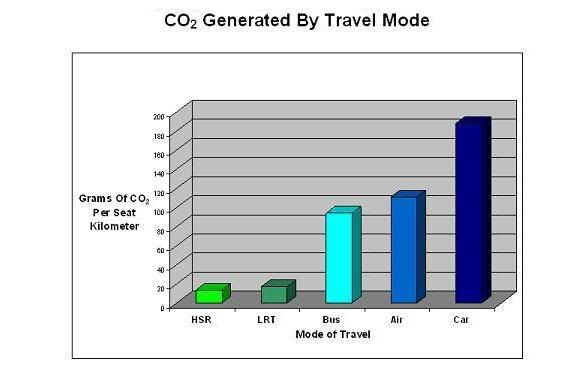The most important news of the week isn't about a lawsuit. It's the report from a top British government climatologist arguing that global warming is going to happen faster and at a higher temperature than previously assumed. A 4C increase - equivalent to 7° Fahrenheit - would have a devastating impact on rainfall patterns, agriculture, and sea levels. Even if 4C is the upper end of the scale, the more widely accepted 2C figure is damaging enough, and a sign that we need to delay no further on implementing global warming solutions.
California has just such a solution on the November ballot - Proposition 1. It's worth reviewing just what the true environmental impact of high speed rail will be:
-Reduce carbon dioxide emissions equivalent to removing 1.4 million cars from the road, and take the place of nearly 42 million annual city-to-city car trips (Final EIR p. 92)
-Reduce CO2 emissions by up to 17.6 billion pounds/year (Quentin Kopp op-ed)
-Reduce California’s oil consumption by up to 22 million barrels/year (same as above)
According to the Final EIR 63% of intercity trips over 150 miles in California are taken by car (scroll to page 12). This is a major factor in causing most of California to be out of compliance with state clean air goals. Given that HSR would be much faster than driving between California's major metro regions, and will likely be less costly as well by 2018, HSR would make a significant dent in those car trips and therefore in the pollution they spew.
HSR provides a VAST carbon emissions savings over other forms of transportation:
(Image from Alberta High Speed Rail)
HSR will also help reduce air pollution. A 2006 Fresno Bee article explained that lung problems have soared among residents in recent years, and the San Joaquin Valley Air Pollution Control District estimated that to counter this trend, the region needed to eliminate 400 tons of pollution per day by 2011. High speed rail would help accomplish that task.
The California Air Resources Board in June issued its draft scoping plan for implementation of the AB 32 carbon reduction goals. They cited high speed rail as one of the methods the state will need to use to achieve the targeted reductions.
Those who are willing to jeopardize passage of Prop 1 by suing because they didn't get their way on the alignment decision or because they don't want safer, cleaner tracks in their neighborhood are overlooking all of these benefits. This isn't anything like oil rigs on the Alaska North Slope or on the California coast. The worst that might happen are tracks through some ranches near Pacheco Pass. The trains will tunnel beneath the pass itself and Pacheco Pass State Park. If that's the price we have to pay for achieving important carbon reductions, I think it's well worth paying.
Because California has failed for decades to act on climate change and energy independence, we are past the point where we can make easy choices. Everything we do to solve the energy-environment-climate crisis will have a possible downside. What we need now is leadership and action. We need to get started on our long-overdue high speed rail project and pass Prop 1, because if it fails at the polls, it's not coming back to the ballot for a long time.
Van Jones, who knows a thing or two about environmental policy, is exhorting audiences to move from opposition to proposition. Without it, he argues, we have no hope of stopping the right-wing's destructive environmental policies. We don't have the political room to be fighting each other over the small differences, and we certainly don't have the time to be suing because someone didn't get their way.
It's not easy to advocate for mass transit in California. Anytime a project is proposed, parochial concerns often derail even valuable projects - witness LA County's MTA tax plan. We have a pathetic rail infrastructure partly because few are willing to accept a compromise in the interest of investing in a better system. How long will we go around in these circles before we finally decide to act?
HSR is one of the most environmentally friendly projects California has considered in a very long time. It won't solve all our problems, but it's the necessary first step. It's time we rallied together to support the passage of Proposition 1 and take the lead in fighting for a better 21st century environment for all Californians.
Thursday, August 7, 2008
Perspective
NOTE: We've moved! Visit us at the California High Speed Rail Blog.
Subscribe to:
Post Comments (Atom)

1 comment:
Running HSR exclusively on renewable electricity would be the easiest way to reduce CO2 emissions from California's transportation sector.
By "exclusive", I mean that at the end of each year, the total number of MWh consumed by the HSR system must be matched by an equal number of incremental MWhs produced from solar, wind, tidal, wave, biomass or geothermal sources.
For the purposes of climate change, is not necessary that every single MWh be generated renewably precisely when it is consumed. An excess on one day can make up for a shortfall on another.
Post a Comment